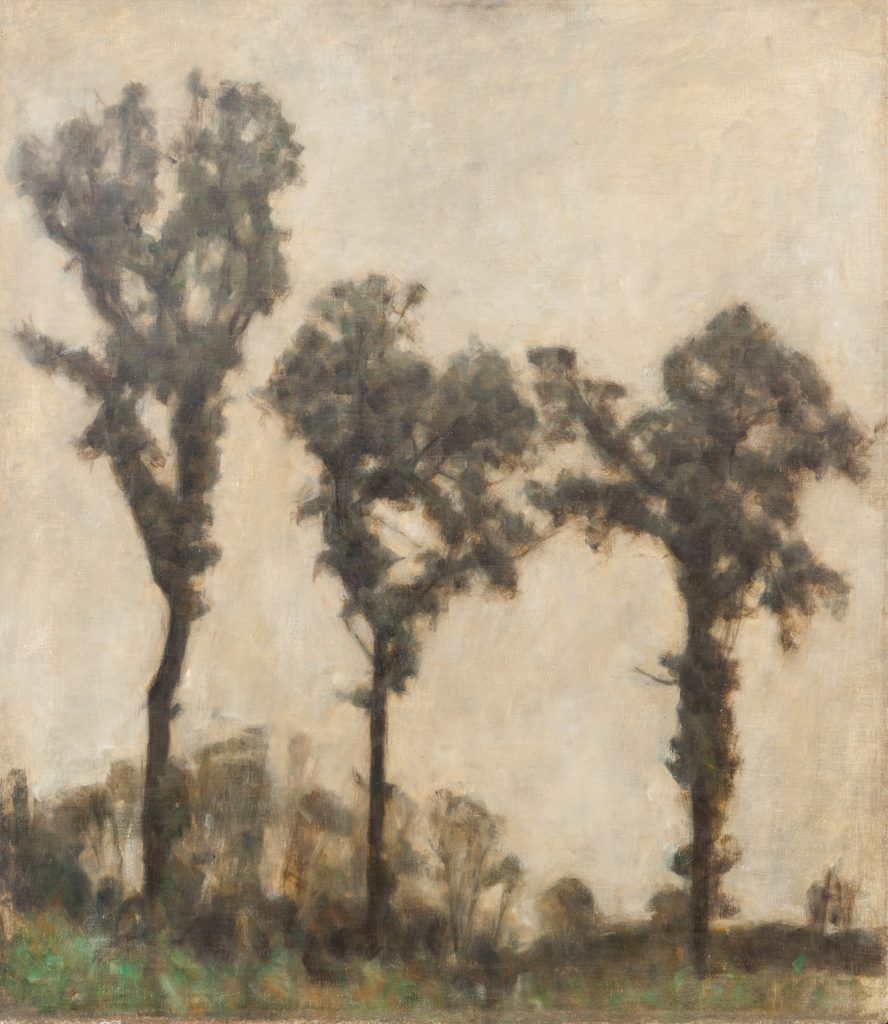Fritstaaende Traeer paa Slotsruinen
Free-standing trees on the castle ruins
Oil on canvas, ca. 1920
Size
79 x 69 cm
Provenance
Possibly with Dr. Søren Soelberg Winge (1874-1935), Vordingborg, Denmark; Museumsbygningen Kunstauktioner, Copenhagen, 2 September 1998, lot 86; Where acquired by the present owner, Denmark
Exhibition
An intriguing view of an old Scandinavian castle by Svend Hammershøi. What is described as castle ruins are obscured by the branches of three olive-green and black trees. Their all-dominating aspect in the foreground, as well as the low angle view which prevents from seeing the ground, undeniably give a poetic and symbolic dimension to the scene. Svend and his brother Vilhelm had a close relationship. In fact, they shared a similar approach for intimate and silent subjects but Svend developed it in his own aesthetic. While Vilhelm preferred to paint interiors scenes, Svend focused on open countryside and landscapes. Vilhelm and Svend would frequently walk together in forest and share subjects. Trees are key figures in Svend’s corpus as, since his teens, he painted those and wrote about it in his correspondence. According to him, just like old buildings and ruins, they have an inner force of divine source. Trees are often combined with castles or cathedrals he saw during his trips in Denmark – the Prinsens palace in Copenhague, the Frederiksborg castle, as well as country castles – and throughout Europe – Christ Church and the Margaret Tower, seen in Oxford. On few occasion, Vilhelm departed from his interior views and represented such scenes in a very similar way[1].
The present artwork was very likely exhibited in Svend Hammershøi’s 1926 retrospective in Copenhague. It could have then been the no. 65 of the catalogue which is titled: “Vordingborg. Træ Paa Slotsruinen med Gaasetaarnet i baggrunden” [Vordingborg. Tree on the castle ruin with the Goose Tower in the background][2]. However, a label on the ancient frame indicates the no. 53 which corresponds in the catalogue as “Fritstående træ på Slotsruinen” [Free-standing tree on the castle ruins]. The painting’s title doesn’t situate the scene. A first hypothesis would be that the location is Koldinghus, a 13th-century castle of Jutland, which Svend Hammershøi painted[3]. Another likelier hypothesis locates the scene as the 12th-century Vordingborg castle, on the island of Sjaelland. Svend also painted by the ruins of this fortress. The provenance, Dr. Søren Soelberg Winge, who was presumably the first owner, provides credit to that theory. Winge was a local politician in Vordingborg from 1911 to 1917. His doctor’s office was actually on the castle square and he may have wished for a motif from where he was living. It is certain that his collection contained other views of the castle.
We are thankful to Hendrik Groenveld, Anne-Mette Villumsen, and Conni Ramskov for their kind help in the cataloguing of the present painting.
[1] See: Vilhelm Hammershøi, St Peter’s Church, Copenhague, 1906, oil on canvas, 133 x 118 cm, Copenhague, Statens Museum for Kunst; Vilhelm Hammershøi, The Jews College Rabbinical Seminary in Guilford Street, London), 1912-1913, oil on canvas, 51 x 41.5 cm, Schleswig, Stiftung Schleswig-Holsteinische Landesmuseen, Schloss Gottorf.
[2] See for a similar composition: 1926, oil on board, 47 x 38 cm, Paris, Artcurial, anonymous sale, 16 April 2019, lot 70.
[3] Svend Hammershøi, Ruins of Koldinghus castle, 1911, oil on canvas, 100 x 80 cm, Kolding, Museet på Koldinghus.






